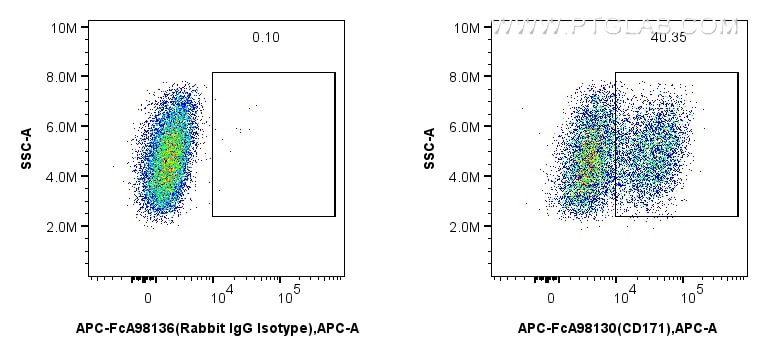Validation Data Gallery
Tested Applications
| Positive FC detected in | SK-N-SH cells |
Recommended dilution
| Application | Dilution |
|---|---|
| Flow Cytometry (FC) | FC : 5 ul per 10^6 cells in 100 μl suspension |
| This reagent has been pre-titrated and tested for flow cytometric analysis. The suggested use of this reagent is 5 ul per 10^6 cells in a 100 µl suspension or 5 ul per 100 µl of whole blood. | |
| Sample-dependent, Check data in validation data gallery. | |
Product Information
APC-FcA98130 targets L1CAM/CD171 in FC applications and shows reactivity with human samples.
| Tested Reactivity | human |
| Host / Isotype | Rabbit / IgG |
| Class | Recombinant |
| Type | Antibody |
| Immunogen |
CatNo: Eg0209 Product name: Recombinant Human L1CAM protein (Myc Tag, His Tag) Source: mammalian cells-derived, pHZ-KIsec Tag: Myc & 6*His Domain: 20-1120 aa of BC126229 Sequence: IQIPEEYEGHHVMEPPVITEQSPRRLVVFPTDDISLKCEASGKPEVQFRWTRDGVHFKPKEELGVTVYQSPHSGSFTITGNNSNFAQRFQGIYRCFASNKLGTAMSHEIRLMAEGAPKWPKETVKPVEVEEGESVVLPCNPPPSAEPLRIYWMNSKILHIKQDERVTMGQNGNLYFANVLTSDNHSDYICHAHFPGTRTIIQKEPIDLRVKATNSMIDRKPRLLFPTNSSSHLVALQGQPLVLECIAEGFPTPTIKWLRPSGPMPADRVTYQNHNKTLQLLKVGEEDDGEYRCLAENSLGSARHAYYVTVEAAPYWLHKPQSHLYGPGETARLDCQVQGRPQPEVTWRINGIPVEELAKDQKYRIQRGALILSNVQPSDTMVTQCEARNRHGLLLANAYIYVVQLPAKILTADNQTYMAVQGSTAYLLCKAFGAPVPSVQWLDEDGTTVLQDERFFPYANGTLGIRDLQANDTGRYFCLAANDQNNVTIMANLKVKDATQITQGPRSTIEKKGSRVTFTCQASFDPSLQPSITWRGDGRDLQELGDSDKYFIEDGRLVIHSLDYSDQGNYSCVASTELDVVESRAQLLVVGSPGPVPRLVLSDLHLLTQSQVRVSWSPAEDHNAPIEKYDIEFEDKEMAPEKWYSLGKVPGNQTSTTLKLSPYVHYTFRVTAINKYGPGEPSPVSETVVTPEAAPEKNPVDVKGEGNETTNMVITWKPLRWMDWNAPQVQYRVQWRPQGTRGPWQEQIVSDPFLVVSNTSTFVPYEIKVQAVNSQGKGPEPQVTIGYSGEDYPQAIPELEGIEILNSSAVLVKWRPVDLAQVKGHLRGYNVTYWREGSQRKHSKRHIHKDHVVVPANTTSVILSGLRPYSSYHLEVQAFNGRGSGPASEFTFSTPEGVPGHPEALHLECQSNTSLLLRWQPPLSHNGVLTGYVLSYHPLDEGGKGQLSFNLRDPELRTHNLTDLSPHLRYRFQLQATTKEGPGEAIVREGGTMALSGISDFGNISATAGENYSVVSWVPKEGQCNFRFHILFKALGEEKGGASLSPQYVSYNQSSYTQWDLQPDTDYEIHLFKERMFRHQMAVKTNGTGRVRLPPAGFATE 相同性解析による交差性が予測される生物種 |
| Full Name | L1 cell adhesion molecule |
| Calculated molecular weight | 1257 aa, 140 kDa |
| GenBank accession number | BC126229 |
| Gene Symbol | L1CAM |
| Gene ID (NCBI) | 3897 |
| Conjugate | APC Fluorescent Dye |
| Excitation/Emission maxima wavelengths | 650 nm / 660 nm |
| Form | |
| Form | Liquid |
| Purification Method | Protein A purification |
| UNIPROT ID | P32004 |
| Storage Buffer | PBS with 0.09% sodium azide and 0.5% BSA{{ptg:BufferTemp}}7.3 |
| Storage Conditions | Store at 2-8°C. Avoid exposure to light. Stable for one year after shipment. |
Background Information
L1CAM, also known as NCAM-L1 or CD171, is a cell adhesion molecule of the immunoglobulin superfamily. It is a 200-220 kDa transmembrane glycoprotein composed of six Ig-like domains and five fibronectin type III repeats followed by a transmembrane region and a highly conserved cytoplasmic tail (PMID: 3412448; 22796939). L1CAM is primarily expressed in the nervous system and is involved in neuron-neuron adhesion, neurite fasciculation, outgrowth of neurites, cerebellar granule cell migration, neurite outgrowth on Schwann cells and interactions among epithelial cells of intestinal crypts (PMID: 3412448; 10767310). L1CAM is overexpressed in many human cancers and is often associated with bad prognosis (PMID: 27267927; 26111503).
Protocols
| Product Specific Protocols | |
|---|---|
| FC protocol for APC L1CAM/CD171 antibody APC-FcA98130 | Download protocol |
| Standard Protocols | |
|---|---|
| Click here to view our Standard Protocols |

